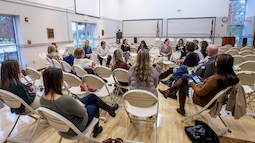CHSP brings together experts to ‘connect the dots’ on neonatal abstinence syndrome

“When people hear a baby crying, they say, ‘We have to do something.’ Yes, we do.”
Dr. Kathy Wedig, a clinical neonatologist, spoke those words last month to a crowd of around 65 people during a seminar titled “Connecting the Dots,” which aimed to bring together health professionals, funders, researchers and community partners to identify, discuss, plan and execute solutions to neonatal abstinence syndrome — a term used to describe a group of symptoms that occur when babies experience withdrawal from drugs they were exposed to in the womb.
Ohio University’s College of Health Sciences and Professions (CHSP) partnered with Northern Kentucky University, Marshall University, Ohio River Valley Addiction Research Consortium and the Ohio Alliance for Innovation in Population Health (The Alliance) to host the event at the Athens Community Center on Nov. 2.
Dean Randy Leite welcomed attendees, speakers and panelists to the forum saying CHSP wanted to drive the effort and address some of the issues involved with opioid abuse. Ohio University President M. Duane Nellis also issued a welcome, recognizing the serious challenges facing the region, state and country and calling for unity regarding the discovery of solutions to opioid addiction and the neonatal abstinence syndrome crisis.
Wedig, an associate professor of clinical pediatrics at the University of Cincinnati and the keynote speaker for the event, talked about how happy she was with the title of the conference.
“’Connecting the Dots’ is perfect because that’s what we have to do. We need to connect the dots between children and families,” she said.
The crowd listened intently to Wedig’s words as she described the effects of drugs on a baby’s brain, gastrointestinal system and autonomic nervous system that controls breathing, sweating, sneezing, fever, etc. She said these systems can be affected in as little as 10 weeks of gestation — a time period in which some may not even yet know they’re pregnant.
Wedig urged medical professionals to treat babies by paying attention to each individually. She said neonatal abstinence syndrome isn’t relegated to any socioeconomic class and that avoiding misdiagnosis is crucial. She also touched on allowing development of the baby to occur naturally and to resist the urge to medicate unnecessarily.
During the conference, three panels were convened and spoke on the topics of funding, research and community groups. The funder panel included Tara Kunkel, of the United States Department of Justice, Bureau of Justice Assistance. She detailed ways to apply for federal funding for opioid-related grants and emphasized being thorough and early when it comes to applications. Tracy Plouck, an executive in residence for CHSP and for The Alliance, expanded on the need for collaboration and highlighted the use of champions to the cause. She said those both in the know of a proposed project and those who can be convinced of a project’s need, such as legislators, are useful in influencing people who can contribute.
Carrie Baker, a healthcare professional of more than 15 years, delivered a story of her personal experience involving family and neonatal abstinence syndrome. Baker spoke of the difficulties in treating her adopted son who suffered from withdrawal when information on neonatal abstinence syndrome was not readily available. At the same time, medical professionals still struggle with consistent treatment strategies. Baker has been an advocate with legislators, pushing for more efforts for research on neonatal abstinence syndrome. Her personal story moved the audience to ask more questions and personalized the experience.
“Neonatal abstinence syndrome is a serious condition, not just a byproduct of the opioid crisis. These are people who are born into this without a choice and we need to find ways to help these babies,” said Rick Hodges, director of The Alliance. “I want to thank all those who presented and attended the conference. Getting people like this together to work collaboratively is key to finding ways to help treat this condition.”
